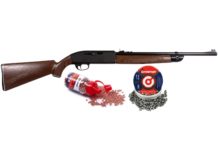CLICK HERE for more from CASH COURIER NEWSLETTER, Winter/Spring 2018
By Anne Muller, C.A.S.H. Courier Editor
Image from a hunting site
I recall going to the NYS Department of Environmental Conservation (DEC) in the 1990s and walking into the moose project manager’s office who was researching the reintroduction of moose into NYS. He was working out the time frame from the beginning of the project to the time when hunting could begin. First, they need to establish a historical basis for a “reintroduction” and not an “introduction” so that the species is not considered “alien.” The DEC actually confessed that moose were extirpated from the state because of hunting. Now they are trying to bring them back for hunters. While impacts on the non-hunting public need to be considered, they are factored in to a reintroduction as they are also the purported impetus for hunting to begin. The “need” to hunt is justified to a public that has little knowledge of how wildlife management works. Fake news is distributed through media channels and towns that any dangerous increase in the population “just happened,” when in fact it was choreographed.
Shockingly, a preliminary report the moose manager had just completed and casually handed me showed calculations of how many moose-car collisions and human fatalities could occur before the public would demand hunting.
Consider that a male moose weighs between 850 and 1500 pounds, and a female weighs between 450 and 800 lbs. This results not just in a human injury, but in a human fatality, including the moose! So, not only animal fatalities are calculated by game managers who are anxious to introduce another lucrative game species, but human fatalities are calculated as well. Humans as well as moose are considered mere collateral damage in the sport hunting business.
MOOSE AS FOOD?
Let’s jump to the safety issue of eating animal flesh directly from the wild. When hunters jump on board the “Hunters for the Hungry” bandwagon, the public is at risk. There are so many unknowns as to where the animal has traveled, what s/he had eaten or drunk, what physical conditions the animal had, coupled with the fact that there is no inspection for lead contamination, temperature changes, and mishandling. To donate wild animal meat to people via any food charity should be made illegal, and lawsuits against charities and donors of wild animal flesh should be brought by families of recipients who become ill from eating the flesh.
People who depend on food from charities often have compromised immune systems and should be protected by the same food and quality laws that apply to everyone else. Why won’t restaurants take this flesh? The obvious reason has to do with health concerns. Why then would charities wish to endanger the health of people who trust them to provide a safe meal, with food that is approved for human consumption.
At the time I was researching Hunters for the Hungry, I was told by the Bear Mountain Museum and Zoo they had been approached by hunters, but refused to take the flesh of hunted animals for their zoo animals!!
Please visit our earliest article “Sportsmen Against Hunter” or “Sportsmen” Against the Hungry?
CLICK HERE for more from CASH COURIER NEWSLETTER, Winter/Spring 2018
See more Articles















































